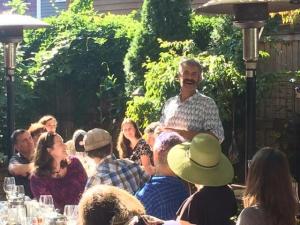
FOUR CULTURED COURSES WITH CULTURE
This post originally appeared on Boston University's Gastronomy Blog.
After weeks of preparation, Chef Geoff Lukas of Sofra Bakerycapped off the Boston Fermentation Festivalweekend with a Fermentation-themed Brunch. It was held on September 28th on the outdoor patio at Oleana Restaurant in Cambridge. While the warm fall day and cozy patio makes for an excellent brunch on any Sunday, diners were in for a special morning of fermented foods, fermented beverages and conversation about fermentation, culture and community.

Thirty fermentation fans joined special guest Sandor Katz, author of The Art of Fermentation and Wild Fermentation, for four courses of fermented culinary delights. Each of the dishes was an expertly executed blend of cultural traditions from different geographic regions. Fermented beverage pairings accompanied each dish and Katz offered quips and insights as each course was presented.
Lukas is a fermentation enthusiast. He encourages fermenters to go beyond sauerkraut and try out more advanced ferments. His ‘Fermentation 201’ talk at the previous day’s festival was an excellent primer for the brunch. During his talk, he introduced the audience to cultural fermenting traditions practiced around the world and gave a sneak peek into his upcoming brunch menu.
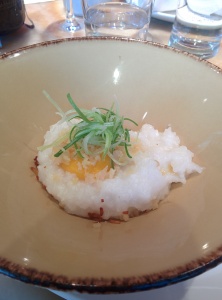
Diners started out with a fermented tea as Katz offered to correct a misnomer that appeared in Wild Fermentation. “No, not all black teas are fermented,” explained Katz, a simple misunderstanding given the slight, and perhaps fuzzy, difference between curing and fermenting. While not a black tea, the Pu’er from China’s Yunan province was made from fermented dried red tea leaves.
The tea accompanied the first course highlighting Asia. While congee is usually soupy, Lukas offered a soft fluffy mound of the mildly fermented rice porridge. It was sprinkled with caramelized koji grains which are jasmine rice grains with a mold used for secondary fermentation. Lukas jokingly told the crowd, “I never thought I would be in love with a mold.” A slightly sour egg yolk pickled in kimchi brine and soy sauce was nested in the congee and topped with a delicate white kimchi.
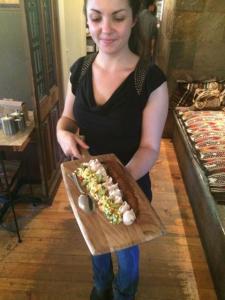
Lukas moved on to the Americas for his second course. Chicha is a commonly known beverage in South and Central America typically made with fermented maize, although the ingredients and preparation can vary from country to country. At this brunch, however, chicha referred to a variety of fruit wines. A sour cherry chichavinegar was used to marinate thin fluke fillets for a ceviche accompanied by a tangy Cherokee-style fermented corn relish and an aged mole negro. While most may know mole as a seasoned, savory cacao sauce from the Oaxaca region of Mexico, this aged version was earthy and tangy. It grounded the sharper sourness of the fermented corn relish and vinegar. Night Shift’s Fallen Apple Aged Cider offered a sweet and funky pairing.
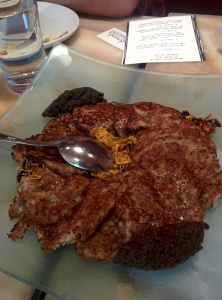 Next up was a fermented interpretation of a Sunday brunch staple, the pancake. Using techniques from Africa, a yeasty and sour fermented lentil and barley pancake anchored this course. Diners successively paired pancakes with each of three accompaniments – a fermented sunflower ugiri butter, a fermented sesame ugiri butter and a sunflower petal marmalade. The sunflower ugiri offered potent, earthy and smoky flavors while the sesameugiri was a lighter and nuttier counterpart. Both were nicely complimented by honey-fermented sunflower petals. The real standout was the mead Lukas started weeks earlier. The herbal-infused anise and African blue basil mead stood up to the strong flavors while the sweet carbonation lightened things up.
Next up was a fermented interpretation of a Sunday brunch staple, the pancake. Using techniques from Africa, a yeasty and sour fermented lentil and barley pancake anchored this course. Diners successively paired pancakes with each of three accompaniments – a fermented sunflower ugiri butter, a fermented sesame ugiri butter and a sunflower petal marmalade. The sunflower ugiri offered potent, earthy and smoky flavors while the sesameugiri was a lighter and nuttier counterpart. Both were nicely complimented by honey-fermented sunflower petals. The real standout was the mead Lukas started weeks earlier. The herbal-infused anise and African blue basil mead stood up to the strong flavors while the sweet carbonation lightened things up.
To end the meal, Lukas returned to the regional cuisines he knows best, those of the Middle East. While fermentations are not usually described as ‘rich and decadent’, the salshir was just that. Meaning “milk head” in Farsi, it is made by fermenting gently heated and separated un-homogenized milk until the desired texture and flavor is achieved. The skimmed off cream ‘head’ is the salshir, which is reminiscent of whipped sweet butter. Acidy, salt-fermented plums and sweet candied tulip petals beautifully matched the creamy base. Black honeycomb gave a chewy final touch. Overall, the dish played well with the traditional Persian sour and fizzy yogurt drink called dough.
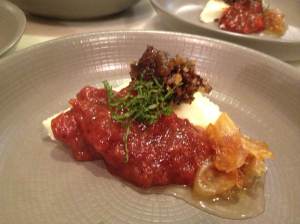
After an activity-packed Boston Fermentation Festival, the brunch proved an engaging and relaxing way to wrap up the weekend. Diners came from as far away as South Dakota. Most were avid fermenters. As the last course was cleared, it was apparent many diners would head home to try out these new dishes on their own. Based on the number of people hurriedly writing down Lukas’ recipe for anise hyssop and African blue basil mead, there is certainly a batch in progress somewhere. If you missed out, get your own mead started at home: pack a container with anise hyssop and African blue basil leaves and flowers, cover with a blend of one part honey and four parts water, let ferment, and stir frequently.
Leave a Reply